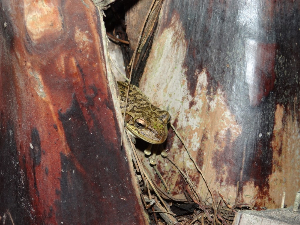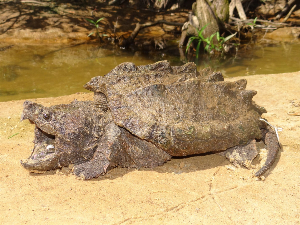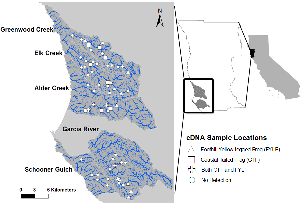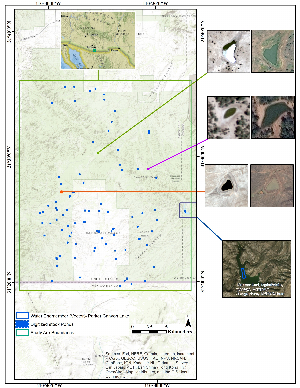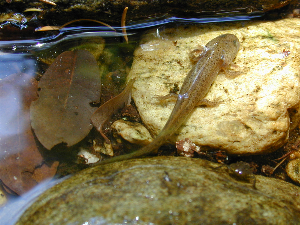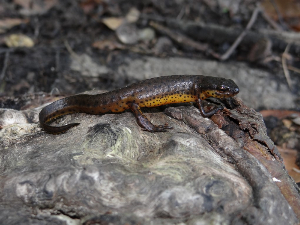Search ARMI Database
Search term(s)
Contribution Number
Search Results
879 record(s) found.
Papers & Reports OSTEOPILUS SEPTENTRIONALIS (Cuban Treefrog)
Authors: Brad M Glorioso; K Macedo; B R Maldonado; C J Hillard; I N Morenc; E S Grimes
Date: 2018 | Outlet: Herpetological Review 49(4):709
A note on the geographic distribution of the Cuban Treefrog (Osteopilus septentrionalis), describing a new parish record and probable establishment in St. Charles Parish.
Papers & Reports Feeding times of Amphiuma tridactylum at Reelfoot Lake, Tennessee
Authors: Brad M Glorioso; Mathew L Niemiller; V A Cobb
Date: 2010 | Outlet: Journal of the Tennessee Academy of Science 85(3-4):87-90
Feeding activity times were determined for Amphiuma tridactylum in a roadside slough adjacent to Reelfoot Lake in northwestern Tennessee. Twenty-nine A. tridactylum were captured using baited deep-water crawfish nets, with more than half of the captures being large adults. Despite the majority (82.4%) of trapping effort being concentrated in daytime hours, 82.7% of A. tridactylum captures were at night. Capture rates during nighttime hours were more than 25 times greater than during daytime capture rates. Though nocturnal, the mid-day captures indicated that A. tridactylum may exit their burrows during the day. This study also provides an alternative trapping method for Amphiuma, in which feeding times can be accurately determined.
Papers & Reports AMBYSTOMA MACULATUM (Spotted Salamander). REPRODUCTION.
Authors: Brad M Glorioso; Hardin J Waddle; J M Hefner
Date: 2012 | Outlet: Herpetological Review 43(4):627-628
This is a note on reproduction in Spotted Salamanders (Ambystoma maculatum) describing clutch sizes and several instances of inadvertant passive integrated transponder tag loss by tagged females via oviposition.
Papers & Reports Nocturnal arboreality in snakes in the swamplands of the Atchafalaya Basin of south-central Louisiana and Big Thicket National Preserve of southeast Texas
Authors: Brad M Glorioso; Hardin J Waddle
Date: 2017-03-29 | Outlet: The Journal of North American Herpetology 2017(1):11-18
The southeastern United States is home to a diverse assemblage of snakes, but only one species, the Rough Greensnake (Opheodrys aestivus), is considered specialized for a predominantly arboreal lifestyle. Other species, such as Ratsnakes (genus Pantherophis) and Ribbonsnakes/Gartersnakes (genus Thamnophis), are widely known to climb into vegetation and trees. Some explanations given for snake climbing behavior are foraging, thermoregulation, predator avoidance, and response to flood. Reports of arboreality in snake species typically not associated with life in the trees (such as terrestrial, aquatic, and even fossorial species) usually come from single observations, with no knowledge of prevalence of the behavior. Here, we report on arboreality of snake species detected during 8 years of night surveys in the Atchafalaya Basin of south-central Louisiana and 5+ years of night surveys in Big Thicket National Preserve in southeast Texas. We recorded a total of 1,088 detections of 19 snake species between the two study areas, with 348 detections above ground level (32%). The Rough Greensnake and Western Ribbonsnake (Thamnophis proximus) accounted for nearly 75% of total arboreal detections among the two study areas. However, with one exception, all snake species detected more than once between both study areas had at least one arboreal detection. These observations demonstrate that snakes with widely varying natural histories may be found in the trees at night, and for some species, this behavior may be more common than previously believed.
Papers & Reports A trapping survey targeting head-started alligator snapping turtles in southwest Louisiana
Authors: Brad M Glorioso; L J Muse; C J Hillard; B R Maldonado; J Streeter; Charles D Battaglia; Hardin J Waddle
Date: 2020 | Outlet: Journal of Fish and Wildlife Management
Papers & Reports OCCURRENCE OF A SUITE OF STREAM-OBLIGATE AMPHIBIANS IN TIMBERLANDS OF MENDOCINO COUNTY, CALIFORNIA, EXAMINED USING ENVIRONMENTAL DNA
Authors: Brian J Halstead; Caren S Goldberg; Robert B Douglas; Patrick M Kleeman; David W Ulrich
Date: 2020-12-31 | Outlet: Northwestern Naturalist 101(3):194-209
Stream-obligate amphibians are important indicators of ecosystem health in the Pacific Northwest, but distributional information to improve forest management is lacking in many regions. We analyzed archived DNA extracted from water samples in 60 pools within streams in private timberlands in Mendocino County, California, for 3 California Species of Special Concern—Coastal Tailed Frogs (Ascaphus truei), Foothill Yellow-legged Frogs (Rana boylii), and Southern Torrent Salamanders (Rhyacotriton variegatus)—to better understand their distributions in the region. Both Coastal Tailed Frog and Foothill Yellow-legged Frog occurrence was affected by whether silt or organic matter was a dominant substrate in the sampled pool, and Foothill Yellow-legged Frog occurrence also was affected by water temperature. Foothill Yellow-legged Frog occurrence had a strong, positive association with water temperature, with occurrence unlikely below 14°C and very likely above 16°C, and a positive association with silt or organic substrates in pools, which was likely an indicator of higher-order stream reaches. In contrast, Coastal Tailed Frogs had a negative association with silt or organic substrates. Historical visual detections were generally congruent with findings using eDNA, but differences highlight important areas for further study. Detection probabilities of eDNA of both frogs was positively affected by water temperature. We did not detect Southern Torrent Salamanders using eDNA at any sites. Our study reinforces that ecological relationships of these species are varied and indicates the importance of maintaining the integrity of streams with diverse characteristics for conserving stream amphibians.
Papers & Reports Survival estimates for the invasive American Bullfrog
Authors: P E Howell; Erin Muths; Brent H Sigafus; Blake R Hossack
Outlet: Amphibia-Reptilia
We used five years of capture mark-recapture data to estimate annual apparent survival of post-metamorphic bullfrogs in a population on the Buenos Aires National Wildlife Refuge in their invaded range in Arizona, U.S.A.
Papers & Reports Estimating inundation of small waterbodies with sub-pixel analysis of Landsat imagery: long-term trends in surface water area and evaluation of common drought indices
Authors: I Sall; Christopher J Jarchow; Brent H Sigafus; Lisa A Eby; M J Forzley; Blake R Hossack
Outlet: Remote Sensing in Ecology and Conservation
Small waterbodies are numerically dominant in many landscapes and provide several important ecosystem services, but automated measurement of waterbodies smaller than a standard Landsat pixel (https://0.09 ha) remains challenging. To further evaluate sub-Landsat pixel techniques for estimating inundation extent of small waterbodies (basin area: https://0.06 – https://1.79 ha), we used a partial spectral unmixing method with matched filtering applied to September 1985–2018 Landsat 5 and 8 imagery from southern Arizona, USA. We estimated trends in modeled surface water area each September and evaluated the ability of several common drought indices to explain variation in mean water area. Our methods accurately classified waterbodies as dry or inundated (Landsat 5: 91.3%; Landsat 8: 98.9%) and modeled and digitized surface water areas were strongly correlated (R2 = https://0.70 – https://0.92; bias = -https://0.024 – -https://0.015 ha). Estimated surface water area was best explained by the 3-month seasonal standardized precipitation index (SPI03; July?September) and. We found a wide range of estimated relationships between drought indices (e.g., SPI vs. Palmer Drought Severity Index) and estimated water area, even for different durations of the same drought index (e. g., SPI01 vs SPI12). Mean surface area of waterbodies decreased by ~14% from September 1985 to September 2018, which matched declines in annual precipitation in the area and is consistent with broader trends of reduced inundation extent based on larger waterbodies. Estimated of surface water area and trends over time were also consistent when we limited analyses to waterbodies ? https://0.04 ha or those that varied most in size (based on CV). These results emphasize the importance of understanding local systems when relying on drought indices to infer variation in past or future surface water dynamics. Several challenges remain before widespread application of sub-pixel methods is feasible, but our results provide further evidence that partial spectral unmixing with matched filtering provides reliable measures of inundation extent of small waterbodies.
Papers & Reports A Synthesis of Evidence of Drivers of Amphibian Decline
Authors: Evan HC Grant; David AW Miller; Erin Muths
Outlet: Herpetologica
ABSTRACT:—Early calls for robust long-term time series of amphibian population data are now being realized after 25 years of focused research. Inference from individual studies and locations have contributed to a basic consensus on drivers of these declines. Until recently there were no large-scale syntheses of long-term time series to test hypotheses about the generality of factors driving population dynamics at broad spatial scales. Through the U.S. Geological Survey Powell Center for Analysis and Synthesis, we brought together a group of scientists to elucidate mechanisms underlying amphibian declines in North America and Europe. We used time series of field data collected across dozens of study areas to make inferences with these combined data using hierarchical and spatial models. We bring together results from four syntheses of these data to summarize our state of knowledge of amphibian declines, identify commonalities among the results that suggest further avenues of study, and suggest a way forward in addressing amphibian declines – by looking beyond specific drivers to how to achieve stability in remaining populations. The common thread of these syntheses is that declines are real but not ubiquitous, and that multiple factors drive declines but the relative importance of each factor varies among species, populations and regions. We also found that climate is an important driver of amphibian population dynamics. However, the sensitivity to change varies among species in ways unlikely to explain overall rates of decline. Thirty years after the initial identification of a major catastrophe for global biodiversity, the scientific community has empirically demonstrated the reality of the problem, identified putative causes, provided evidence of their impacts, invested in broader scale actions, and attempted meta-analyses to search out global drivers. We suggest an approach that focuses on key demographic rates that may improve amphibian population trends at multiple sites across the landscape.
Papers & Reports A Synthesis of Evidence of Drivers of Amphibian Declines
Authors: Evan HC Grant; David AW Miller; Erin Muths
Outlet: Herpetologica xx: xxx-xxx
ABSTRACT: Early calls for robust long-term time series of amphibian population data, stemming from discussion following the first World Congress of Herpetology, are now being realized after 25 yr of focused research. Inference from individual studies and locations have contributed to a basic consensus on drivers of amphibian declines. Until recently there were no large-scale syntheses of long-term time series data to test hypotheses about the generality of factors driving population dynamics at broad spatial scales. Through the U.S. Geological Survey’s Powell Center for Analysis and Synthesis, we brought together a group of scientists to elucidate mechanisms underlying amphibian declines in North America and Europe. We used time series of field data collected across dozens of study areas to make inferences with these combined data using hierarchical and spatial models. We bring together results from four syntheses of these data to summarize our state of knowledge of amphibian declines, identify commonalities that suggest further avenues of study, and suggest a way forward in addressing amphibian declines—by looking beyond specific drivers to how to achieve stability in remaining populations. The common thread of the syntheses is that declines are real but not ubiquitous, and that multiple factors drive declines but the relative importance of each factor varies among species, populations and regions. We also found that climate is an important driver of amphibian population dynamics. However, the direction and magnitude of sensitivity to change vary among species in ways unlikely to explain overall rates of decline. Thirty years after the initial identification of a major catastrophe for global biodiversity, the scientific community has empirically demonstrated the reality of the problem, identified putative causes, provided evidence of their impacts, invested in broader scale actions, and attempted meta-analyses to search out global drivers. We suggest an approach that focuses on key demographic rates that may improve amphibian population trends at multiple sites across the landscape.
Papers & Reports Effects of Snowpack, Temperature, and Disease on Demography in a Wild Population of Amphibians
Authors: Erin Muths; Blake R Hossack; Evan HC Grant; David S Pilliod; Brittany A Mosher
Date: 2020-06 | Outlet: Herpetologica
Understanding the demographic consequences of interactions among pathogens, hosts, and weather conditions is critical in determining how amphibian populations respond to disease and in identifying site-specific conservation actions that can be developed to bolster persistence of amphibian populations. We investigated population dynamics in Boreal Toads relative to abiotic (fall temperatures and snowpack) and biotic (the abundance of another anuran host and disease) characteristics of the local environment in Wyoming, USA. We used capture-recapture data and a multi-state model where state is treated as a hidden Markov process to incorporate disease state uncertainty and assess our a priori hypotheses. Our results indicate that snowpack during the coldest week of the winter is more influential to toad survival, disease transition probabilities, and the population-level prevalence of the amphibian chytrid fungus (Batrachochytrium dendrobatidis) in the spring, than temperatures in the fall or the presence of another host. As hypothesized, apparent survival at low (i.e., <25 cm) snowpack (https://0.22 [CI: 0.15–0.31]) was lower than apparent survival at high snowpack (https://90.65 [CI: 0.50–0.78]). Our findings highlight the potential for local environmental factors, like snowpack, to influence disease and host persistence, and demonstrate the ecological complexity of disease effects on population demography in natural environments. This work further emphasizes the need for improved understanding of how climate change may influence the relationships among pathogens, hosts, and their environment for wild animal populations challenged by disease.
Papers & Reports Editorial: Contributions of Behavior and Physiology to Conservation Biology
Authors: C R Gabor; Susan C Walls
Outlet: Frontiers in Ecology and Evolution
Conservation biology is a rapidly evolving discipline, with its synthetic, multidisciplinary framework expanding extensively in recent years. Seemingly disparate disciplines, such as behavior and physiology, are being integrated into this discipline’s growing portfolio, resulting in diverse tools that can help develop conservation solutions. Behavior and physiology have traditionally been considered separate fields, yet their integration can provide a more comprehensive approach to developing solutions to conservation and management problems. However, demonstrations are needed of how behavior and physiology—either separately or combined—have contributed to conservation success. Examining species’ vulnerabilities to extinction through the lenses of behavior and physiology can provide insight into the mechanisms that drive population declines and extirpations. Our goal is to increase awareness of the benefit of combining behavioral and physiological tools to improve conservation management decisions. Such studies can also help strengthen the basis for evidence-based conservation which, in some cases, has been previously lacking. The diverse studies in our Research Topic illustrate key examples of ways that behavior and physiology can be incorporated into conservation biology. Three main themes emerged from the invited papers with respect to their relevance to conservation: Stress physiology, (2) indicators of health and disease dynamics, (3) and movement ecology. But these themes were also intertwined, thus showing the importance of integrating multiple fields of research to successfully address questions about conservation biology.
Papers & Reports Amphibian responses in the aftermath of extreme climate events
Authors: Gary Bucciarelli; M Clark; Katy S Delaney; Seth PD Riley; H Shaffer; Robert N Fisher; R L Honeycutt; Lee B Kats
Date: 2020-02-25 | Outlet: Scientific Reports 10:3409
Climate change-induced extinctions are estimated to eliminate one in six known species by the end
of the century. One major factor that will contribute to these extinctions is extreme climatic events.
Here, we show the ecological impacts of recent record warm air temperatures and simultaneous peak
drought conditions in California. From 2008–2016, the southern populations of a wide-ranging endemic
amphibian (the California newt, Taricha torosa) showed a 20% reduction to mean body condition and
significant losses to variation in body condition linked with extreme climate deviations. However,
body condition in northern populations remained relatively unaffected during this period. Range-wide
population estimates of change to body condition under future climate change scenarios within the
next 50 years suggest that northern populations will mirror the loss of body condition recently observed
in southern populations. This change is predicated on latter 21st century climate deviations that
resemble recent conditions in Southern California. Thus, the ecological consequences of climate change
have already occurred across the warmer, drier regions of Southern California, and our results suggest
that predicted climate vulnerable regions in the more mesic northern range likely will not provide
climate refuge for numerous amphibian communities.
of the century. One major factor that will contribute to these extinctions is extreme climatic events.
Here, we show the ecological impacts of recent record warm air temperatures and simultaneous peak
drought conditions in California. From 2008–2016, the southern populations of a wide-ranging endemic
amphibian (the California newt, Taricha torosa) showed a 20% reduction to mean body condition and
significant losses to variation in body condition linked with extreme climate deviations. However,
body condition in northern populations remained relatively unaffected during this period. Range-wide
population estimates of change to body condition under future climate change scenarios within the
next 50 years suggest that northern populations will mirror the loss of body condition recently observed
in southern populations. This change is predicated on latter 21st century climate deviations that
resemble recent conditions in Southern California. Thus, the ecological consequences of climate change
have already occurred across the warmer, drier regions of Southern California, and our results suggest
that predicted climate vulnerable regions in the more mesic northern range likely will not provide
climate refuge for numerous amphibian communities.
Papers & Reports Amphibian chytrid prevalence on boreal toads in SE Alaska and NW British Columbia: tests of habitat, life stages, and temporal trends
Authors: Blake R Hossack; Michael J Adams; R K Honeycutt; Jami J Belt; S Pyare
Date: 2020 | Outlet: Diseases of Aquatic Organisms 137:159-165
Tracking and understanding variation in pathogens such as Batrachochytrium dendrobatidis
(Bd), the agent of amphibian chytridiomycosis, which has caused population declines
globally, is a priority for many land managers. However, relatively little sampling of amphibian
communities has occurred at high latitudes. We used skin swabs collected during 2005?2017 from
boreal toads Anaxyrus boreas (n = 248), in southeast Alaska (USA; primarily in and near Klondike
Gold Rush National Historical Park [KLGO]) and northwest British Columbia (Canada) to determine
how Bd prevalence varied across life stages, habitat characteristics, local species richness,
and time. Across all years, Bd prevalence peaked in June and was >3 times greater for adult toads
(37.5%) vs. juveniles and metamorphs (11.2%). Bd prevalence for toads in the KLGO area, where
other amphibian species are rare or absent, was highest from river habitats (55.0%), followed by
human-modified upland wetlands (32.3%) and natural upland wetlands (12.7%)—the same rankorder
these habitats are used for toad breeding. None of the 12 Columbia spotted frogs Rana
luteiventris or 2 wood frogs R. sylvatica from the study area tested Bd-positive, although all were
from an area of low host density where Bd has not been detected. Prevalence of Bd on toads in the
KLGO area decreased during 2005?2015. This trend from a largely single-species system may be
encouraging or concerning, depending on how Bd is affecting vital rates, and emphasizes the
need to understand effects of pathogens before translating disease prevalence into management
actions.
(Bd), the agent of amphibian chytridiomycosis, which has caused population declines
globally, is a priority for many land managers. However, relatively little sampling of amphibian
communities has occurred at high latitudes. We used skin swabs collected during 2005?2017 from
boreal toads Anaxyrus boreas (n = 248), in southeast Alaska (USA; primarily in and near Klondike
Gold Rush National Historical Park [KLGO]) and northwest British Columbia (Canada) to determine
how Bd prevalence varied across life stages, habitat characteristics, local species richness,
and time. Across all years, Bd prevalence peaked in June and was >3 times greater for adult toads
(37.5%) vs. juveniles and metamorphs (11.2%). Bd prevalence for toads in the KLGO area, where
other amphibian species are rare or absent, was highest from river habitats (55.0%), followed by
human-modified upland wetlands (32.3%) and natural upland wetlands (12.7%)—the same rankorder
these habitats are used for toad breeding. None of the 12 Columbia spotted frogs Rana
luteiventris or 2 wood frogs R. sylvatica from the study area tested Bd-positive, although all were
from an area of low host density where Bd has not been detected. Prevalence of Bd on toads in the
KLGO area decreased during 2005?2015. This trend from a largely single-species system may be
encouraging or concerning, depending on how Bd is affecting vital rates, and emphasizes the
need to understand effects of pathogens before translating disease prevalence into management
actions.
Papers & Reports Egg counts of Southern Leopard Frog, Lithobates sphenocephalus, egg masses from southern Louisiana, USA
Authors: Brad M Glorioso; L J Muse; Hardin J Waddle
Date: 2020-02-27 | Outlet: Herpetology Notes 13:187-189
This note quantifies the number of embryos from a series of egg masses of the Southern Leopard Frog observed in the Atchafalaya Basin of south-central Louisiana.
Papers & Reports Contrasting demographic responses of toad populations to regionally synchronous pathogen (Batrachochytrium dendrobatidis) dynamics
Authors: Blake R Hossack; Robin E Russell; Rebecca M McCaffery
Date: 2020 | Outlet: Biological Conservation 241: 108373
Batrachochytrium dendrobatidis (Bd), a fungal pathogen that causes amphibian chytridiomycosis, has been implicated in population declines globally. To better understand how Bd affects survival and how threats vary spatially and temporally, we conducted long-term (range: 9–13 yrs) capture-recapture studies of boreal toads (Anaxyrus boreas) from three similar communities in western Montana. We also estimated temporal and spatial variation in population-level Bd prevalence among populations and the potential role of co-occurring Columbia spotted frogs (Rana luteiventris) in driving infection dynamics. Hierarchical models that accounted for detection uncertainty revealed Bd reduced apparent survival in one population that declined, was unassociated with survival in one stationary population, and was associated with increased survival in one population that is near extirpation. Despite different effects of Bd on hosts, pathogen prevalence was similar and synchronous across the populations separated by 111 – 176 km. Variation in Bd prevalence was driven partly by seasonal temperatures, but opposite the direction expected. Bd prevalence also decreased sharply over time across all populations, unrelated to trends in temperature, boreal toad survival, or infection dynamics of co-occurring Columbia spotted frogs. Toad Bd prevalence increased when frog abundance was high, consistent with an amplification effect. However, Bd prevalence of toads decreased as Bd prevalence of spotted frogs increased, consistent with a dilution effect. Our results reveal surprising variation in responses to Bd and show pathogen prevalence is not predictive of survival or population risk, and they illustrate the complexity in understanding disease dynamics across multiple populations.
Papers & Reports Factors Facilitating Co-occurrence at the Range Boundary of Shenandoah and Red-backed Salamanders
Authors: Staci M Amburgey; David AW Miller; Evan HC Grant
Date: 2020-02-14 | Outlet: Journal of Herpetology
The transition from species in allopatry to sympatry, i.e., the co-occurrence zone, allows for investigation of forces structuring range limits and provides evidence of the evolutionary and population responses of competing species, including mechanisms facilitating co-occurrence (e.g., character displacement). The Shenandoah Salamander (Plethodon shenandoah), an endangered plethodontid, is limited to three mountaintops in Shenandoah National Park, Virginia, USA. This species’ distributional limits are attributed to competitive exclusion by the Red-backed Salamander (P. cinereus). Recent work showed range overlap between these species is greater than previously thought, requiring investigation of species morphology, behavior, and demographic measures in single-species and co-occurrence zones that might facilitate such overlap. We analyzed individual characteristics from two years of transect surveys to see if traits differed within and outside co-occurrence zones. Measures showed species- and zonal-specific differences, but we found limited support for character displacement. Both species were larger in the co-occurrence zone, indicating larger animals might better compete for resources or that symmetric competition restricts dispersal or recruitment processes at the co-occurrence zone. Microhabitat use also differed by species across transects, with Red-backed Salamanders using more rock microhabitats in the co-occurrence zone, potentially due to competition for microclimates that minimize physiological stress. The lack of strong evidence of differentiation in situ at the range edge suggests competition may be weaker than previously thought with other factors contributing to the range limits of Shenandoah Salamanders.
Papers & Reports Highly variable rates of survival to metamorphosis in wild boreal toads (Anaxyrus boreas boreas)
Authors: J Crockett; Larissa L Bailey; Erin Muths
Date: 2020-02 | Outlet: Population Ecology
Life history theory suggests that long-lived, pond-breeding amphibians should have low and highly variable early life-stage survival rates, but this theoretical expectation is often untested and the causes of variation are usually unknown. We evaluated the impact of hydroperiod, presence of a pathogen (Batrachochytrium dendrobatidis [Bd]), presence of a potential predator (cutthroat trout Oncorhychus clarki stomias), and whether animals had been reintroduced into a site, on survival of early life stages of boreal toads (Anaxyrus boreas boreas). We used a multi-state mark-recapture framework to estimate survival of boreal toad embryos from egg to metamorphosis at four sites over five years. We found substantial spatial and temporal variation in survival to metamorphosis and documented some evidence that monthly tadpole survival was lower in sites with Bd, and without trout, and at permanent sites. Our results support theories of amphibian life history, aid in the management of this species of conservation concern, and contribute to our knowledge of the ecology of the species. Additionally, we present methodology that allows practitioners to account for different lengths of time between sampling periods when estimating survival probabilities and which is especially applicable to organisms with distinct biological stages.
Papers & Reports Batrachochytrium salamandrivorans (Bsal) not detected in an intensive survey of wild North American amphibians
Authors: Hardin J Waddle; Daniel A Grear; Brittany A Mosher; G ra Campbell; Michael J Adams; Adam R Backlin; William J Barichivich; Adrianne B Brand; Gary Bucciarelli; Daniel L Calhoun; T Chestnut; J M Davenport; A Dietrich; Robert N Fisher; Brad M Glorioso; Brian J Halstead; Marc P Hayes; R K Honeycutt; Blake R Hossack; Patrick M Kleeman; J A Lemos-Espinal; Jeffrey M Lorch; Brome McCreary; Erin Muths; Christopher A Pearl; Katherine LD Richgels; C W Robinson; Mark F Roth; Jennifer C Rowe; Walt J Sadinski; Brent H Sigafus; I Stasiak; S Sweet; Susan C Walls; C J Watkins-Colwell; C Le White; L A Williams; Megan E Winzeler
Date: 2020-08-03 | Outlet: Scientific Reports 10:13012
Papers & Reports Monitoring of Boreal Toads (Anaxyrus boreas) in Klondike Gold Rush National Historical Park: Survey design recommendations and trends in wetland occupancy and amphibian chytrid
Authors: Thierry C Chambert; Jami J Belt; Blake R Hossack
Outlet: Final report to NPS
Boreal Toads (Anaxryus boreas, previously Bufo boreas) have been monitored in and around Klondike Gold Rush National Historical Park (KLGO) since 2004. Because of their significant cultural and ecological importance, and due to threats of habitat change and the presence of the pathogenic chytrid fungus (Batrachochytrium dendrobatidis), the surveillance of Boreal Toad populations has become a priority. We analyzed data collected by the park during 2005–2018 to assess the global trend of toads’ occupancy in KLGO. To provide insight into the likelihood that sites produce metamorphs, we also estimated survival of larvae from early in the season (June-July) to late season (July-August) at 8 core sites that were surveyed intensively during most years. In addition, we used simulations and statistical power analyses to make recommendations on how to improve the sampling design of this monitoring program.

